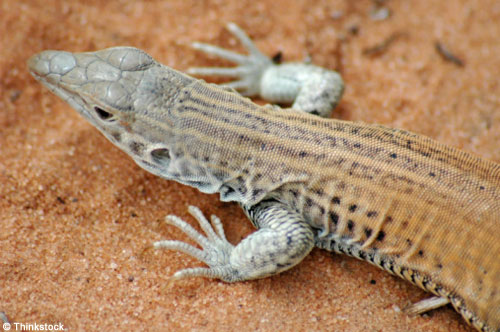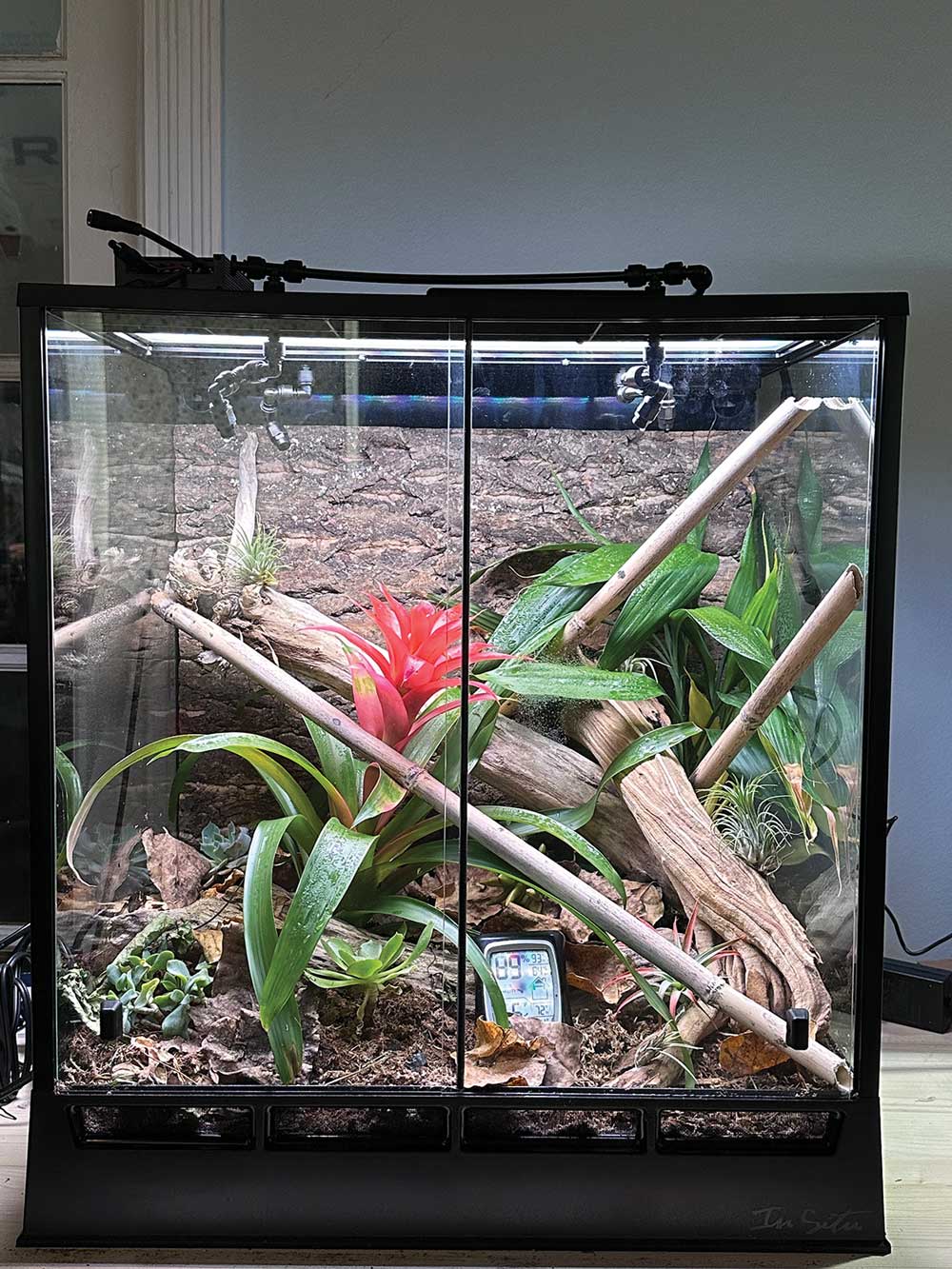Bonus content from the August 2011 REPTILES magazine article, “Understanding What’s Underfoot.”
 Every natural vivarium must have a substrate designed for the specific type of environment, which meets the needs of the animals and plants to be housed in the vivarium. These substrates simulate the kinds of soils found in the animals’ natural environments, but are designed to function appropriately in an enclosed vivarium environment. They promote your herp’s physical and mental health, natural behavior, longevity and breeding, as well as the health, vigor and beauty of plants. Complete, pre-packaged natural vivarium substrates are not yet available on the market. However, it is easy, fast and inexpensive to prepare a natural vivarium substrate using substrate materials that are readily available at reptile and pet shops, home improvement centers, nurseries, plant stores and some rock supply yards.
Every natural vivarium must have a substrate designed for the specific type of environment, which meets the needs of the animals and plants to be housed in the vivarium. These substrates simulate the kinds of soils found in the animals’ natural environments, but are designed to function appropriately in an enclosed vivarium environment. They promote your herp’s physical and mental health, natural behavior, longevity and breeding, as well as the health, vigor and beauty of plants. Complete, pre-packaged natural vivarium substrates are not yet available on the market. However, it is easy, fast and inexpensive to prepare a natural vivarium substrate using substrate materials that are readily available at reptile and pet shops, home improvement centers, nurseries, plant stores and some rock supply yards.

Having a substrate that mimics a reptile species’ native environment can play a role in how well a reptile fares in captivity
There are three basic kinds of natural vivarium substrate mixes: forest, desert and bog. The general environments for which these are used are described below. Each type of mix can be further altered as necessary to meet the needs of certain kinds of animals and plants, as indicated in the recipes.
The forest mix is used in tropical rain forest, temperate forest or woodland vivaria. It simulates the kind of highly organic, moist, biologically active soils that build up in areas with dense covers of trees and other vegetation, usually humid and with high rainfall, at least seasonally. Herps typically living in such environments include many frogs (especially treefrogs), salamanders, many geckos, anoles and other lizards, many snakes and some tortoises. Most tropical plants, including most sold as “houseplants,” do well in this mix.
The desert mix is used in desert and other arid-environment vivaria. It simulates a common type of relatively dense, high-mineral, low-organic soil found in many such environments. Herps from these areas include many lizards, snakes, tortoises and a few hardy frogs and toads that typically remain in estivation for long periods between rains. It is composed mostly of mineral materials, is fairly dense, drains readily, but holds some moisture and remains relatively cool at lower levels, and develops a crust on top for traction and to provide stability for the creation of burrows.
The bog mix is used in bog or marsh vivaria, also sometimes called “shoreline” vivaria. It provides a good anchoring medium for plant roots, holds nutrients, supports healthy biological activity and tends to stay in place better than simple aquarium sands. It is composed mostly of mineral material. It meets the needs of most bog and aquatic plants and animals, mostly amphibians that live in bogs, marshes or around the fringes of ponds, lakes or rivers.
All of these mixes should be prepared several days to a week ahead of time, slightly moistened and allowed to rest in an open container before use. Each component listed in the recipes is described at the end of the recipes.
Basic Forest Vivarium Substrate Mix
- 2 parts partially composted leaves
- 2 parts medium grade bark/wood chip product
- 1 part ground coconut husk fiber (coir).
- Organic, complete general purpose plant fertilizer, including trace minerals – use only half the amount of fertilizer per volume of mix recommended on package
Chunky Forest Vivarium Substrate Mix
(Used in areas of vivarium where plants that require excellent drainage are planted, such as many terrestrial bromeliads and orchids)
- 1 part basic forest vivarium planting mix (from above)
- 2 extra parts bark/wood chips
Basic Desert Vivarium Substrate Mix
- 2 parts natural sand
- 1 part ground coconut husk fiber
- ½ part fully composted leaves
- Organic, complete general purpose plant fertilizer, including trace minerals – use only one-third the amount of fertilizer per volume of mix recommended on package
- Sulfur – 1 teaspoon per gallon of finished substrate mix
Basic Bog Vivarium Substrate Mix
- 2 parts natural sand. For this mix only, the sand should be washed several times to remove the dust.
- 1 part ground coconut husk fiber
- ¼ to ½ part fully composted leaves
- Quality commercial pond plant fertilizer formulated for use in fish ponds – use only one-quarter the amount per volume of mix recommended on package
- Inoculation of bottom medium (about a handful of sand or mud) from a healthy, established aquarium or pond, to introduce beneficial bacteria
Leaves, partially composted – These are important for contributing the starting population of natural beneficial bacteria and fungi that create a biologically active mix that will break down and eliminate animals’ waste products and maintain a healthy, long-term environment. It is also an important source of organic material and nutrients for plants. Partially composted leaves consist of the dead leaf litter in various states of decomposition (from the newly-fallen surface material to the fine matter several inches down) found around the base of trees and shrubs. The best kinds of leaves for this are small, relatively tough types such as live (scrub) oak, alder, elm, birch, aspen, poplar, beech, rose, etc. Avoid leaves that are too large, such as magnolia, sycamore, etc., or which are delicate and turn mushy too quickly, like maple. Avoid types that may be significantly toxic, like oleander, in vivaria that may house herbivorous herps. Do not collect from areas that may have been exposed to insecticide or herbicide. To eliminate any possible unwanted bugs and most weed seeds, spread leaves out on a tarp or blanket in a dry area for two or three days. Bugs will leave, dry up or get eaten by birds.
Leaves, fully composted – Same as above leaves, except that the freshly fallen leaves and large pieces are removed. Fully composted leaves are the very fine, dark and crumbly leaf material found in the lower layers of leaf litter.
Bark/Wood Chips – This is important for creating texture, friability, aeration, drainage and longevity of the mix. Make sure the bark/chip product is fir or aspen – most packaged and marketed for reptile or orchid use are. Do not use bark or wood chips of redwood, cedar, pine or cypress, which contain various resins, oils, phenols, tannins, acids and other toxic compounds that are dangerous to herps and plants. Bark/wood chips come in several sizes or grades, typically small, medium and large. The medium grade is best for most vivarium uses.
Coconut husk fiber, also called coir – This is a by-product of the coconut industry that is now being extensively used as a substrate material for plants and herps. It is a superior replacement for peat moss. It comes in bags or compressed blocks. Soak and squeeze out several times before use to remove any possible excess salts from processing and to create a moist, fluffy material.
Natural sand – Natural sand is usually derived from degraded, or ground, rock and is composed of a variety of particle sizes, with both very fine material (clay) and larger grains up to the size of a small pea. It may seem “dirty” to you. This is good. Some commercial sands that usually qualify would include decomposed granite (DG) and other crushed rock sands, such as crushed sandstone. The best place to look for these sands is at rock supply companies. Most carry DG and other natural sands. Sandy soils collected from unpolluted desert or arid areas will work, but not dirt from your yard. Some home improvement warehouses carry DG in bags labeled as “builder’s” or “all-purpose” sand, used for making concrete or a base for brick paving. Avoid aquarium sand, play sand (used for sandboxes, etc.), or silica sand. You don’t want anything with uniform grains or only larger grains. Don’t use sand or rocks from the beach. They may contain excessive amounts of salts that will harm your plants and animals.
Fertilizer, natural or organic, complete general purpose – Use a good all-purpose granular fertilizer with trace minerals. Most fertilizer packages have three large numbers on the label that indicate the percentages of the three major components: nitrogen, phosphate and potash. These numbers should be about equal or with slight variation (e.g., 10-10-10 or 12-5-7, etc.). The most common and important trace minerals that should be included are boron, copper, iron, manganese, molybdenum and zinc. All of this information, called a “guaranteed analysis,” should be listed somewhere on the package.
Fertilizer, pond – Use a quality commercial pond plant fertilizer formulated for use in fish ponds and available from pond, koi or water lily suppliers or some home improvement centers or nurseries.
Sulfur – Powdered sulfur is available at most nurseries and home improvement warehouses. It may be packaged as a soil acidifier or “blueing formula” for hydrangeas and other acid-loving plants. Most of the natural sands used to make the desert vivarium substrate mix are alkaline to some degree, so sulfur is used sparingly here to buffer or balance out the mix, making it more neutral. Neither the fertilizer described above nor sulfur will harm your animals in any way when used as directed here.



